 Add My Company
Add My Company
A Brief Introduction to SPDT Switches

If you work with electrical systems or circuits, you’ve likely encountered various switches controlling the flow of electricity. Like many pressure and vacuum switches and pressure transducers, their purpose is to provide systems with electrical feedback when responding to untimely pressure fluctuations.
Among these, SPDT (Single Pole Double Throw) switches stand out for their versatility in routing currents between multiple load sources. But what exactly are SPDT switches, and why are they so useful?
This brief guide explores the inner workings of SPDT switches along with their common applications across industries. By the end, you’ll better understand if this type of multi-throw switch may be what your system and setup require.
What is an SPDT Switch?
At their core, SPDT switches are devices that work on a break-before-make basis. They feed power from a single source into two separate circuits. Think of them like a railway line switcher in which parts of a train are directed into either one of two subsequent lines.
An SPDT features a single input (pole) that can alternate between two distinct output paths (throws) to control where electricity flows. The break-before-make action can be triggered using a button, lever, toggle, or, in this case, a pressure sensor, which initiates a change in the circuit once a predefined pressure level is reached.
The “single pole” refers to having just one input source of electricity, unlike switches with multiple input sources. The “double throw” means that this one input can connect to either of the two outputs but not simultaneously; it must break the connection with one circuit before making another.
How SPDT Switches Differ From SPST and DPDT
To better understand SPDTs, it can help to compare them with some other common pressure switch configurations:
- SPST (Single Pole Single Throw) – The simplest type of electrical pressure switch that features an on/off output connection from one input source. These are low-cost methods of pressure monitoring with contacts either marked as ‘normally open’ or ‘normally closed’.
- DPDT (Double Pole Double Throw) – These electronic pressure switches contain two separate input sources that can each connect to two outputs. Essentially this is made up of two combined SPDT switch components.
SPDT switches fall in between SPST and DPDT switches as a convenient middle ground. Their ability to alternate between two output circuits from a single input makes them ideal for everything from basic electronics to more heavy-duty electrical rerouting applications.
Example Applications of SPDT Switches
Due to their straightforward yet flexible design, SPDT switches have countless use cases across industries. They can work in any circuit(s) where one switch is needed to power different actions, which can be as simple as an on/off switch or as complex as rerouting circuits that shouldn’t run simultaneously.
- Manufacturing equipment – SPDT switches are often used in machinery to reverse the direction of electric motors, switch between power sources for redundancy, or transfer monitoring signals.
- HVAC systems – It’s common to find them built into heating and cooling systems to switch between air handler units or trigger the different functions.
- Electronics – SPDT switches enable toggling between circuits in test equipment, instrument panels, radio transmitters, and consumer devices.
- Lighting systems – Commercial and residential lighting controls utilise SPDTs for switching between power sources or for gradual dimmer activation.
- Industrial vehicles – Mobile plant equipment like forklifts and HGVs use SPDT switches to control accessories, reverse power sources, and safely isolate circuits.
- Alternative energy – SPDTs are critical for switching between solar/wind/grid inputs and isolating electrical storage systems, as well as switching to hybrid vehicle fuel tanks when batteries deplete.
Importantly, the electromechanical form of standard SPDT switches allows them to reliably handle high current loads. They’re generally more rugged and longer lasting than solid-state electronic alternatives for heavy-duty switching duties.
Choose the Right SPDT Switch for the Job
Now that you understand what SPDT switches do, how can you select the right one for your equipment or industrial requirements?
Defining the incumbent voltage, temperature and climate factors helps guide which SPDT pressure switch models best match your needs from a performance standpoint. Size, mounting orientation, housing materials and actuator types also come into play.
For example, a rugged industrial SPDT toggle switch would suit outdoor machinery better than a light-duty rocker style designed for indoor electronics.
At Applications Engineering, we take the guesswork out of procuring SPDT switches by offering exceptional product selection and expert technical guidance. Our inventory includes SPDT toggles, rockers, rotary selectors and more from leading manufacturers in various ratings, sizes and actuator styles.
Whether you need an adjustable SPDT for complex areas, cylindrical SPDT slide switches for circuit boards, or any other throw configurations, we can supply you with high-quality electromechanical switches quickly. We even supply solid-state switches, SPST switches, and differential pressure switches if needed.
Explore our product range and contact our team to get started today. If you need any assistance identifying an ideal SPDT, we’ll be glad to promptly steer you in the right direction.
For more information on A Brief Introduction to SPDT Switches talk to Applications Engineering Limited

